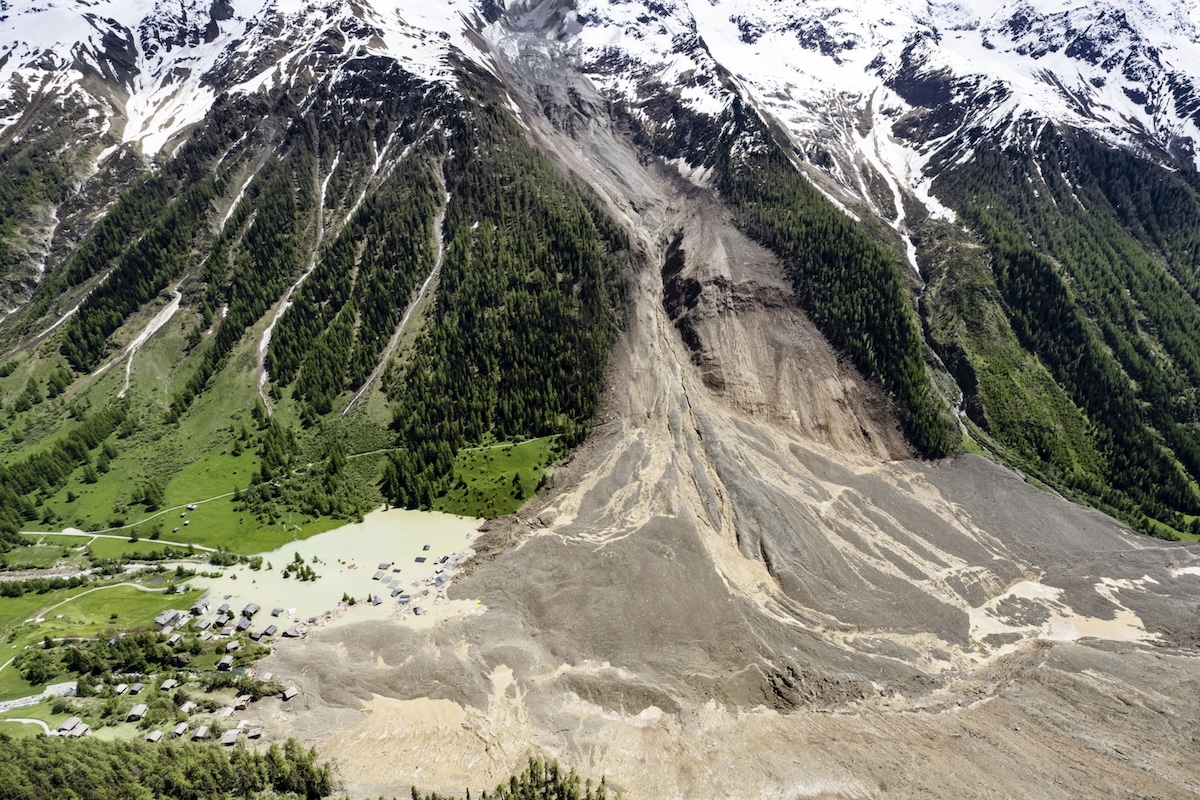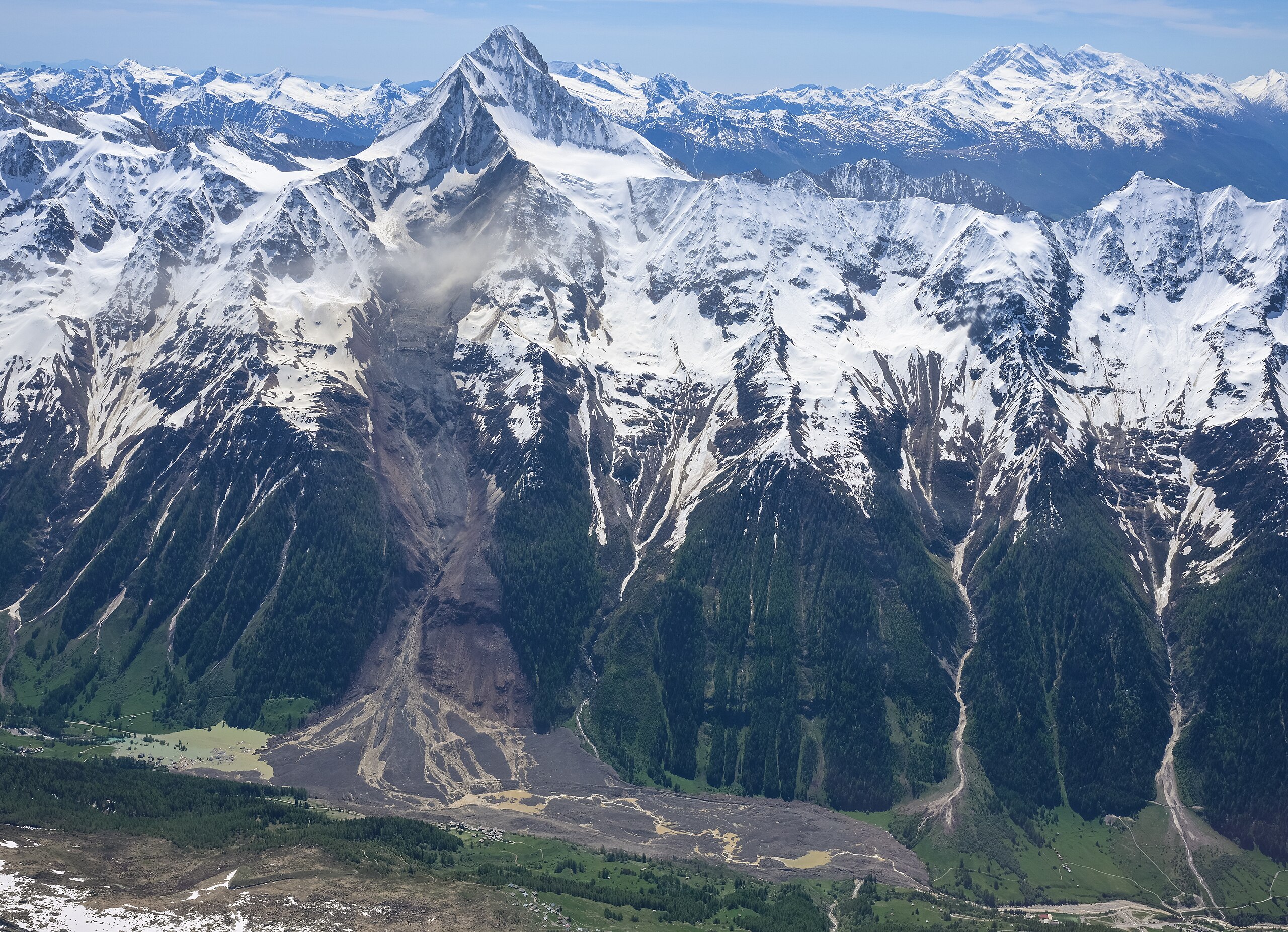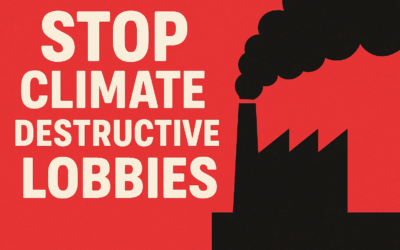HOW MANY BLATTENS DO WE WANT IN YEARS TO COME?
How Swiss finance is driving climate collapse — and making us pay for it
On May 28 2025, the village of Blatten in Valais, Switzerland, was wiped off the map. At 15:24 CEST, ten million cubic meters of rock and ice came crashing down onto the village. In just 28 seconds, homes that had stood for over 600 years were destroyed. Three hundred residents were evacuated. One man, a local sheep farmer whose barn was located outside the evacuation zone, is still missing and presumed dead. Swiss insurers estimate the damage at 320 million Swiss francs (about €341 million).
This wasn’t a natural accident — it was a direct consequence of climate change, supercharged in Switzerland, where temperatures have risen by 2.9°C since pre-industrial times. As glaciologist Professor Wilfried Haeberli puts it: “I know that climate change is behind the Blatten landslide.”

An aerial view of Blatten, Switzerland on May 29, 2025, one day after the landslide. The Atlantic Photo / Facebook
ETH Zurich researchers identified two key processes led to the collapse of the Birch Glacier slope:
- First, glacier retreat and snow loss exposed bare rock to warmer air, weakening its structure.
- Second, melting permafrost allowed rain and meltwater to seep into cracks of the mountain. Repeated freeze–thaw cycles reduced the rock’s internal strength — until it collapsed.
As temperatures rise, these kinds of rock and ice avalanches are becoming more frequent. In 2024, a similar slide hit the Bernina Massif — luckily, no one was hurt.
Switzerland’s warming future is already here
Switzerland is warming nearly twice as fast as the global average, making it a climate crisis hotspot. The result: retreating glaciers, thawing permafrost, and destabilised mountain slopes.
And it’s not just landslides. Extreme weather is becoming more frequent and destructive:
- On July 24 2023, a mini-hurricane struck La Chaux-de-Fonds, killing one man and causing 117 million francs in damage.
- On July 17, 2023, the first out of control forest fire in Bitsch, Valais which burned through 132 hectares of forest, forced hundreds of people to be evacuated and took two weeks to be extinguished completely.
- In 2019, Val-de-Ruz was flooded by 70 to 100 litres of rain per square metre — in just three hours.

Shot of Lötschental, May 30 at 9:38, Bietschhorn Mountain. Source: Federal Office of Topography Swisstopo Rapid Mapping
Who profits from climate destruction — and who pays?
The question of how Switzerland adapts to the escalating climate crisis cannot be separated from the question of responsibility — and justice.
In the wake of the Blatten disaster, both national and cantonal authorities acted swiftly. The Swiss federal government quickly released CHF 5 million in emergency aid to support affected residents and recovery efforts and CHF 10 million from the Valais Council canton. These are welcome steps — but they are reactive, not preventative. Without long-term planning and investment in climate adaptation, communities will remain exposed.
But even more critically, these measures fail to address the root cause: Swiss finance is fuelling the crisis.
Swiss banks and asset managers are among the world’s biggest backers of fossil fuel expansion. According to a 2022 McKinsey report, their investments drive emissions equivalent to 17 times Switzerland’s national carbon footprint. In other words, Swiss finance is exporting destruction on a global scale — while communities at home are left to suffer the consequences.
These short-term profits come at long-term costs to Swiss society — and to the world.
Insurers: Protectors or profiteers?
Insurers are meant to be the safety net for disasters like Blatten — in this case covering 320 million Swiss francs in damages.
But this system is cracking under the pressure of accelerating climate disasters.
Key issues:
-
Coverage gaps: In cantons like Valais, property insurance isn’t compulsory. Thousands remain vulnerable and underinsured.
-
Premium hikes: As climate risk rises, insurers are openly recognising they are likely to their increase premiums or withdraw from high-risk areas — leaving communities stranded.
-
Fossil fuel funding: Swiss insurers like Zurich are major investors in the industries causing this crisis. Zurich alone holds $262 million in fossil fuel assets and is the 6th largest insurer of fossil fuel companies globally (Boycott Bloody Insurance).
Coverage gaps
Switzerland’s insurance system is a patchwork of private and public providers, and coverage varies significantly across cantons. In most areas, property insurance is public and mandatory — and has so far provided a solid safety net. However, in cantons like Geneva, Ticino, Valais, and parts of Appenzell, coverage is private and not compulsory. This leaves communities and homeowners more vulnerable, especially as climate risks grow. If insurers withdraw from high-risk areas — as they are increasingly doing worldwide — residents may be left without coverage, unable to repair their homes or sell their properties.
Premium hikes
But with the increasing frequency and scale of climate disasters, insurers face growing challenges: their traditional risk models and premium calculations are being stretched to the limit. Many Swiss insurers are now that premiums will likely rise in high-risk areas, reflecting the changing climate.
Fossil fuel funding
Adding complexity, Swiss insurers themselves are major investors and insurers of fossil fuels. A report by Boycott Bloody Insurance revealed how Zurich, Switzerland’s biggest insurer is still the 6th biggest insurer of fossil fuel globally and invests at the very least $262 million USD in fossil fuel giants. This means insurers are enabling the very climate destruction they are insuring us against. This conflict of interest underscores the need for urgent action and accountability.
Our demands
BreakFree is a member of the Insure Our Future coalition which calls on Swiss insurers to take responsibility for their role in fuelling the climate crisis. We demand Swiss insurers:
-
Immediately end to insurance for new or expanded coal, oil, and gas projects — across the entire value chain, including liquefied natural gas (LNG);
-
Stop providing insurance services for companies expanding fossil fuel operations or failing to align with a credible 1.5°C pathway;
-
Phase out investments in fossil fuel expansion — starting with an immediate halt to new investments.
We demand UBS and all Swiss banks divest from fossil fuel expansion — and publicly commit to science-based exclusion policies aligned with climate safety.
These demands are not radical — they are essential to protect both the planet and vulnerable communities like Blatten. Without bold and transparent action, Swiss financial institutions will continue to fuel climate destruction while failing to safeguard the people they are meant to protect. It’s time for Swiss insurers and banks to stop driving the crisis — and start being part of the solution.



